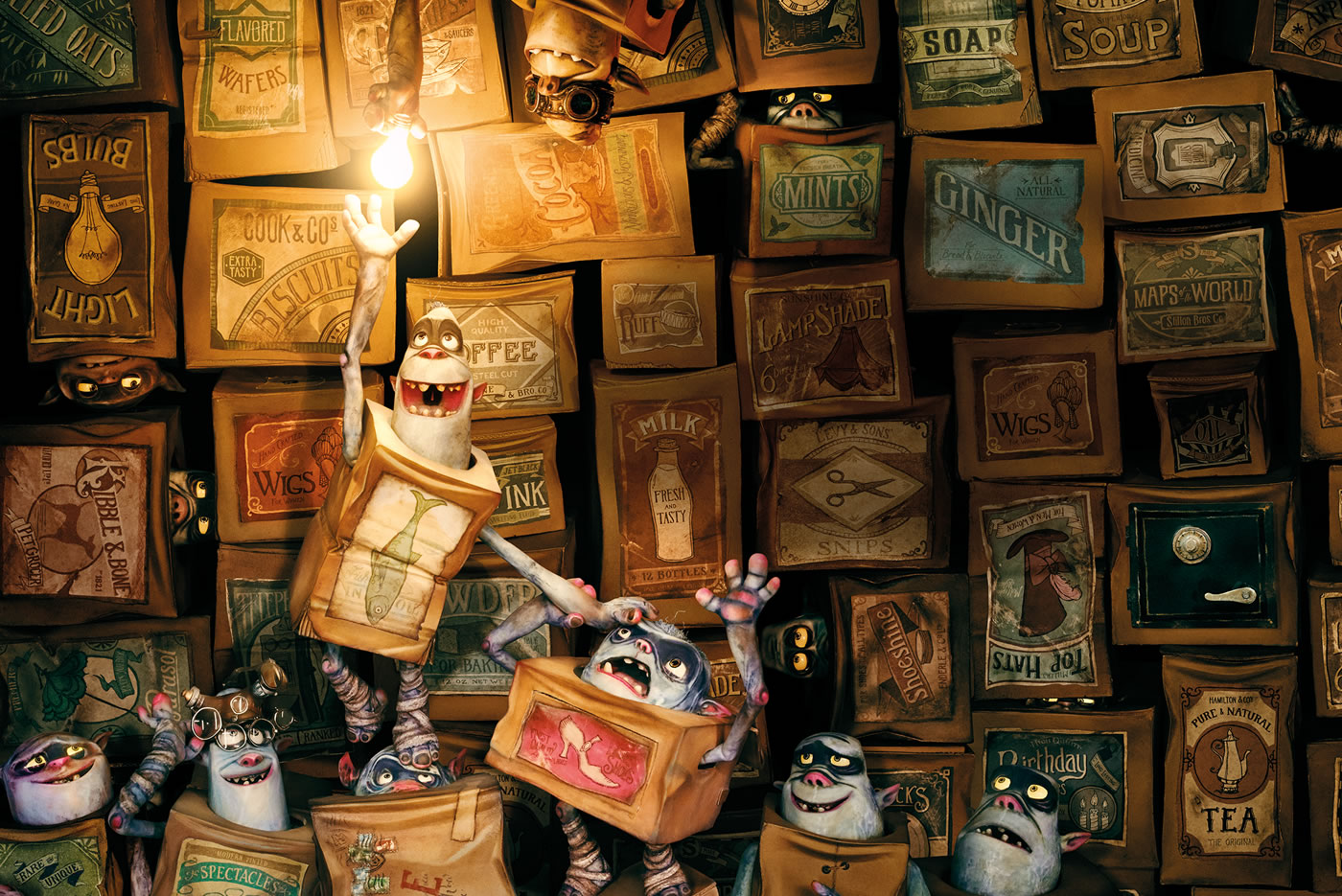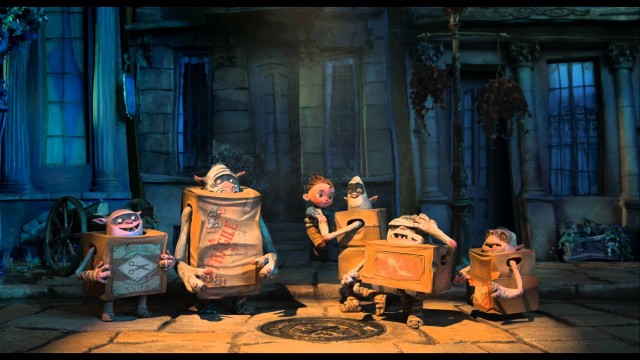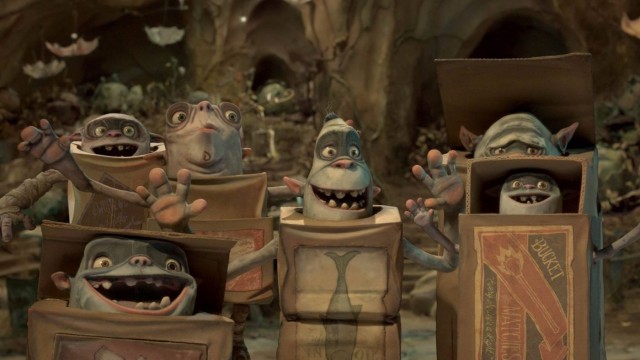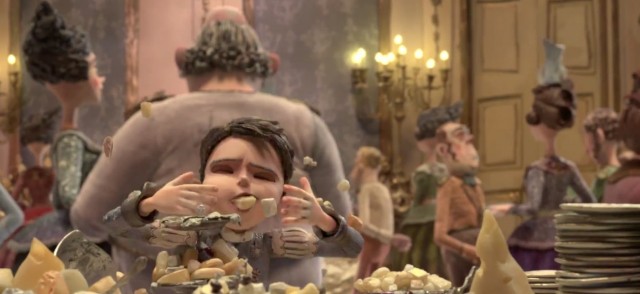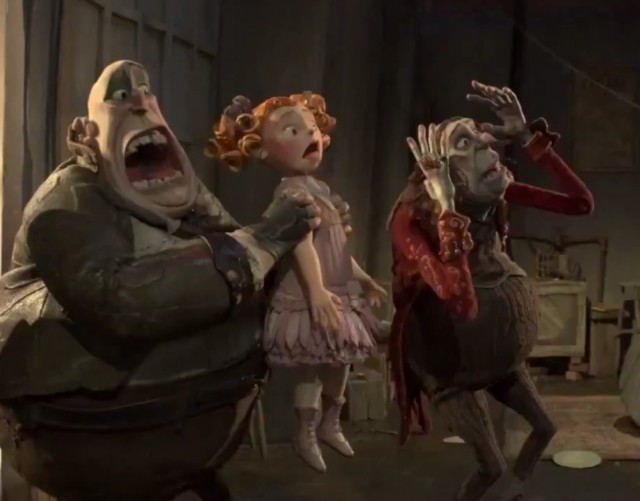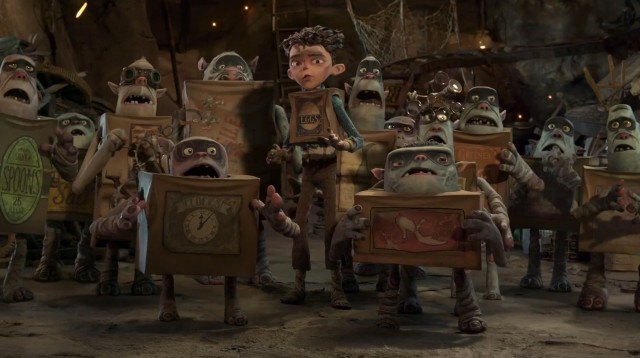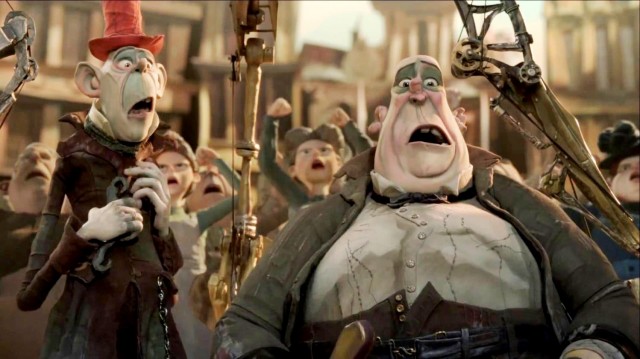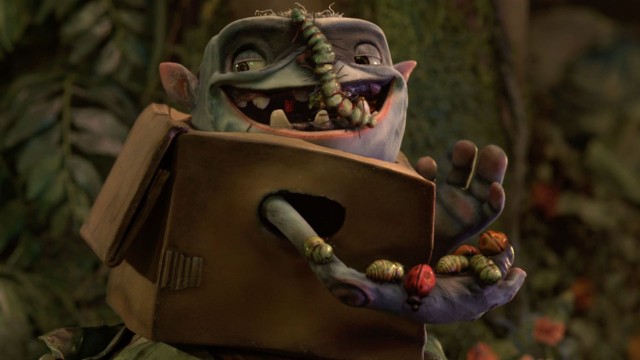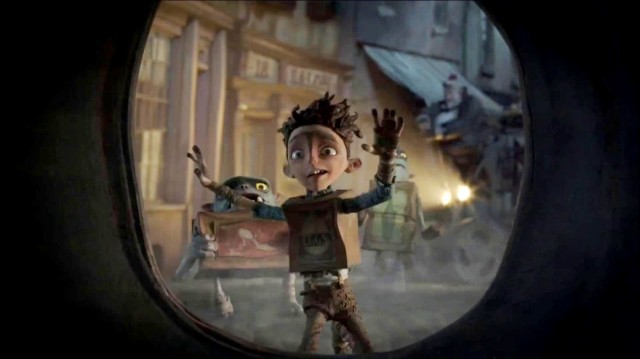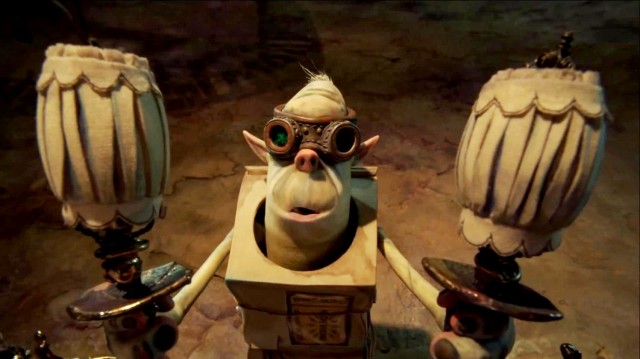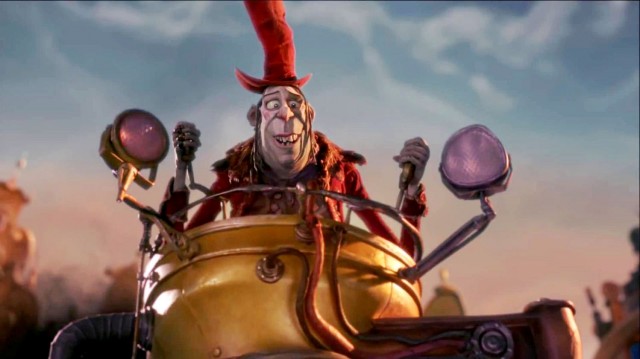Laika have made a name for themselves amongst cult audiences with their progressive and daring stop-motion films. Their previous two projects, Coraline and ParaNorman, failed to sell at the box office, but were nonetheless celebrated amongst film enthusiasts for pushing the envelope of family movies, and including themes and subject matter that no other kid-friendly flick would dare. They encourage kids to ask uncomfortable questions, and parents to embrace occasionally having to give a child an uncomfortable answer.
This daring, unsafe foundation is likely why Laika’s movies have been met with lacklustre sales, despite their high acclaim amongst critics and film enthusiasts.
The Boxtrolls marks the third effort from Laika, loosely inspired by British childrens’ novel, Here be Monsters! by Alan Snow. While it also hasn’t sold great at the box office, it’s at least doing visibly better than ParaNorman in particular, just about breaking even in sales at this point. It’s a small step down from the quality of Laika’s first two movies, having more noticeable flaws in some places, but it’s arguably the best mainstream movie of September this year, and still presents plenty of Laika’s familiar and edgy charm throughout its runtime!
The Boxtrolls is about a young boy named Eggs, voiced by Game of Thrones actor, Isaac Hempstead-Wright, who is apparently snatched by a group of kindly critters, the titular Boxtrolls, who live underground in the fictional European town of Cheesebridge. Believing himself to be a Boxtroll, Eggs lives underground with his adopted brethren, until a plot to exterminate the lot of them forces him into the world above to confront his human identity.
Helping him in this endeavour is Winnie, voiced by Elle Fanning, a rich girl that adores monster folklore, and is neglected by her oblivious and conceited father, Lord Portley-Rind, voiced by Jared Harris. Winnie and Eggs present contrasting viewpoints between the truth and fiction revolving around the Boxtrolls, which serves as most of the movie’s early conflict.
Cheesebridge believes that the Boxtrolls are vicious and bloodthirsty creatures of the night that snatch children from their beds and devour them. This rumour is exacerbated when news gets around about the Trubshaw Baby (Eggs), and how it was stolen by the critters, leading to the entire town living in fear of them.
This leads to an opportunistic pest exterminator, Archibald Snatcher, voiced by Ben Kingsley, attempting to make his way to a high society white hat by promising Lord Portley-Rind that he will exterminate every Boxtroll in the town for a position at Portley-Rind’s table. Being oblivious and self-absorbed, Portley-Rind accepts the proposal.
This is where a small issue crops up; The Boxtrolls are not in any way scary. Yes, this is a kid-friendly movie, so they couldn’t be designed to be that scary without frightening young viewers, but as loveably cute as they are, they’re almost too cute. There’s no way that anyone with half a brain would believe that these innocent tinkerers and scavengers are child-eating menaces. You could chalk it up to gullible and superstitious townsfolk believing everything they hear, but the bad reputation of the Boxtrolls is really a stretch here.
Putting that aside though, the Boxtroll designs are still very appealing. They derive their names from the discarded boxes that they wear as clothing, hence, Eggs, Fish, Shoe, Bucket, etc.. Whatever is on their box is a clue to their identity, though they still have some distinguishing features, such as being different shapes and sizes, having slightly different pigmentation and facial features, and perhaps having an accessory like goggles in some cases. As the movie establishes early on, a Boxtroll’s box is its entire identity.
This is the biggest of the movie’s character-driven themes, that of identity, and how branding by itself can’t fully realize a person. This makes The Boxtrolls feel very smart and contemporary for our modern world, where people are all too happy to try and define themselves by their brands, whether it’s clothing brands, entertainment brands, or anything in between. The movie uses its characters to effectively illustrate that an identity is something you find within yourself, not something you display on your person. After all, people are not Boxtrolls.
Standing in defiance of the idea that branding is folly however is our main villain, Archibald Snatcher, who is determined to make his way to high society at any cost, even disregarding a comically severe health condition in the process. Ben Kingsley once again effectively goes against his image as a majestic, scholarly actor, playing a conniving and disgusting antagonist that is ironically unappealing in image as he is behaviour.
As fun as Kingsley can be in the main villain role however, it’s his two philosophical henchmen, Mr. Trout and Mr. Pickles, played by Nick Frost and Richard Ayoade respectively, that are the most fun to watch. They offer a whole new definition of bumbling goons, continually questioning their actions in the grand scheme of the universe, and hysterically failing at trying to convince themselves that they’re the good guys. It’s a shame that Tracy Morgan’s more outwardly evil Mr. Gristle is left to pick up the maniacal slack for these two in a really uninteresting way, but Mr. Trout and Mr. Pickles are nonetheless two of the most memorable and fun animated underlings to come along in a movie in quite some time! They even feature in a mid-credits sequence that should be especially amusing to fans of stop-motion filmmaking.
The Boxtrolls feels a bit more innocent than the previous two Laika movies, and that might make it feel less deep than the prior two, but the personalities are still realized very well for the most part.
The Boxtrolls tells a smart story that’s occasionally let down in passing by a couple of weak links. As mentioned, the title characters don’t really earn their reputation as something that the townspeople adequately fear, and the movie’s efforts to establish them feel surprisingly sloppy for Laika standards.
This issue comes up when The Boxtrolls begins at such a breakneck pace. Everything happens very quickly, and it’s not until a bit later that the pieces of the story start to fall into place. Even adults will probably be confused by the opening of the movie at first, leaving most children no doubt even more lost as to what’s going on.
Once The Boxtrolls settles into its more comfortable groove though, the story starts to unfold in a more appealing fashion. The journey of Eggs is paced pretty well, and the later portions are definitely where the movie is at its strongest. Some of the twists feel like they pull even more punches in terms of the subject matter, but there are still some neat surprises, which lead into a spectacular climax for the fate of the town and the title characters.
It may suffer from a shaky foundation, but the final resolution of The Boxtrolls is nonetheless satisfying, making any bumps in the journey well worth its destination.
The Boxtrolls marks the feature directing debut of its co-directors, Graham Anable and Anthony Stacchi. The former has only done a few budget video game cutscenes up to this point, and the latter has only done a few short films beforehand. This may not be a vote of confidence, and may explain some of the confusing and sloppy opening beats of The Boxtrolls, but Anable and Stacchi do eventually right the ship, and show off more of their strengths as animated film directors.
Once The Boxtrolls finds its groove, it unfolds with the visual stop-motion panache that one would expect from a Laika film. There’s some really imaginative and appealing visual moments in the movie, and its key character moments are still well-realized. Again, the movie has a problem with tipping its hand and making a few twists obvious, but Laika’s latest is still not wanting for polish.
The Boxtrolls opts out of having a family-friendly, pop-y soundtrack, and instead features a heavier score from Oscar winning composer, Dario Marianelli. Marianelli has composed the soundtracks of V For Vendetta, The Brothers Grimm, Atonement and Pride & Prejudice, which should give you a good idea of the kind of musical composition you’re in for with The Boxtrolls.
Even if it’s not what you would expect, the movie’s score is still varied and interesting, having a mix of heavy and ominous instrumentation, upbeat polka, and a good chunk of classical composition. Don’t worry about things getting too heavy and overbearing though, as there’s still an original and fun single contributed for the movie by Monty Python veteran, Eric Idle!
All in all, it’s a bold and commendable soundtrack for an animated movie, one that’s quirky and enjoyable enough to recommend owning for avid film buffs.
As with any Laika movie, the stop-motion animation in The Boxtrolls is memorable and very well put-together. The dreary, grungy environments of Cheesebridge fit well with the studio’s style, and some of the key visual moments represent some of the studio’s best work to date!
The character designs feel like a refinement from the character style of ParaNorman, with the Boxtrolls in particular having especially creative and striking detail. Even the human characters are given more expression thanks to their diverse appearances though, with their personalities and places in the plot effectively dictating their physical builds. This means that, while characters like Eggs, Winnie and even Lord Portley-Rind look proportionate and grounded, more outwardly villainous and twisted characters like Snatcher and Mr. Gristle look more outwardly ghoulish and abstract.
The Boxtrolls may not have the more surreal visual style of Coraline or ParaNorman, but it still feels like one of the studio’s most visually well-realized movies to date, taking a lot of cues from claymation flicks like those from British studio, Aardman, which helps to make The Boxtrolls feel like an especially British movie, even when made by an American animation studio.
On another note, I saw The Boxtrolls in 3D, and the 3D presentation is a tad hit-or-miss at times. There are some standout visual moments that brilliantly make use of the 3D presentation, but too often, it’s left to sit there with nothing worthwhile to do beyond add a small sense of heightened atmosphere. Making things worse here is the often dark and shadowy visual style, which works against the 3D, making it that much harder to discern in the gloomier environments.
There’s still just enough good points in the 3D presentation to recommend it to viewers who enjoy 3D movies though, since the 3D only adds things to the experience, rather than taking away from it, even if it’s just small things. With that said though, if you’d rather just watch The Boxtrolls flat in 2D, you’re not really missing a whole lot.
The Boxtrolls may be Laika’s weakest movie to date, but that still places it well above the pedigree of most other family flicks, even if it’s well beneath the standard set by Disney/Pixar and Dreamworks Animation. It’s got a few story issues, but still manages to be charming, visually arresting and smart, making it a great family movie for those who don’t mind something a little different, whether for themselves or their children.
The movie may not find its footing right away, but when it does, it delivers the same interesting and bold experience that Laika does best as a stop-motion studio, convention be damned. In fact, the predictable difficulty that comes with marketing Laika movies to family audiences is probably what led to The Boxtrolls being dropped into the box office wasteland of September. Fortunately however, this means that The Boxtrolls easily stands as the top wide movie release of the month, even if it will still mostly thrive as a cult classic, a la Coraline and ParaNorman.
Small flaws considered, the movie still succeeds at most anything that an animated movie should set out to do. It’s got smart subject matter for adults, smart and accessible themes for kids, plenty of polish and production value in its animation, and a great mix of comedy and drama to keep the entertainment value high. Maybe it’s not Laika’s best work, but that certainly doesn’t mean it’s not good work!

